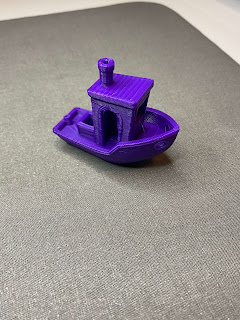This article is brought to you by Lizzsews.
The benchy boat is a 3D print model that has been designed for testing and benchmarking your 3D printer. Use this print to test how your printer is printing and try out different slicing software settings and filaments.
Recommended read: What is PLA
Benchy - short for benchmark!
The features of the benchy:
1. First layer details - On the bottom of the boat, there are shallow letters. These letters will reveal whether or not first-layer blobbing is occurring.
- If first layer blobbing is occurring, your nozzle is too close to the bed. If your print is not sticking to the bed, your nozzle might be too far from the bed. Relevel your printer bed.
Recommended read: How to level the 3d printer bed
2. Small and large horizontal holes - Can see if the printer has ringing or ghosting, vibration.
3. Low slope surfaces - Show the layered structure.
4. Overhang surfaces - Where the filament being extruded is hanging over the previous layer.
- If you have bad overhang angles, try reducing layer height, increasing fan cooling, reducing print speed, and reducing print temperature.
5. Cylindrical shapes - Show fluctuation in roundness, can show overheating.
6. Tiny surface details
7. Symmetrical - The benchy is symmetrical, crookedness and warping can be detected.
8. The hull - Reveals any surface fluctuation, like under or over extrusion, layer separation and/or wobble.
To print it:
- Keep the scale as a 1:1 ratio - this way when it's done printing you can measure it, it should measure 60mm from bow to stern
- Use a layer height of 0.2mm
- Set infill to 10% density
- Set print speed to 50 mm/s
- Set travel print speed up to 150 mm/s, I recommend 100mm/sec-120mm/sec
- The print nozzle diameter at 0.4 mm
Recommended read: What is slicing in the 3D printing files
To experiment with it:
This benchy is perfect for experimenting with different layer heights, infill densities, print speeds, travel speeds, retraction, nozzle diameter, and more.
But, print one benchy out first with the basic settings as stated above, make sure that this benchy prints out perfectly first, before changing any settings.
To experiment with your different settings, print out one benchy with the basic settings, this is your 'control group'. Next, change ONE setting, don't change more than one at a time. Compare your experiment with your control and look at the differences. If you want to change another setting, change that with the original, not with your experiment. See how that one prints and again compare it with your control. If both experiments printed well, you can now try to change the two settings, and see how it prints, again, compared to your control group.
Your benchy will print in about one hour
Recommended read: About my 3D printer
Be sure to like and leave a comment to let me know if you printed the benchy! And don't forget to subscribe to get notified for our next blog post!




Comments
Post a Comment